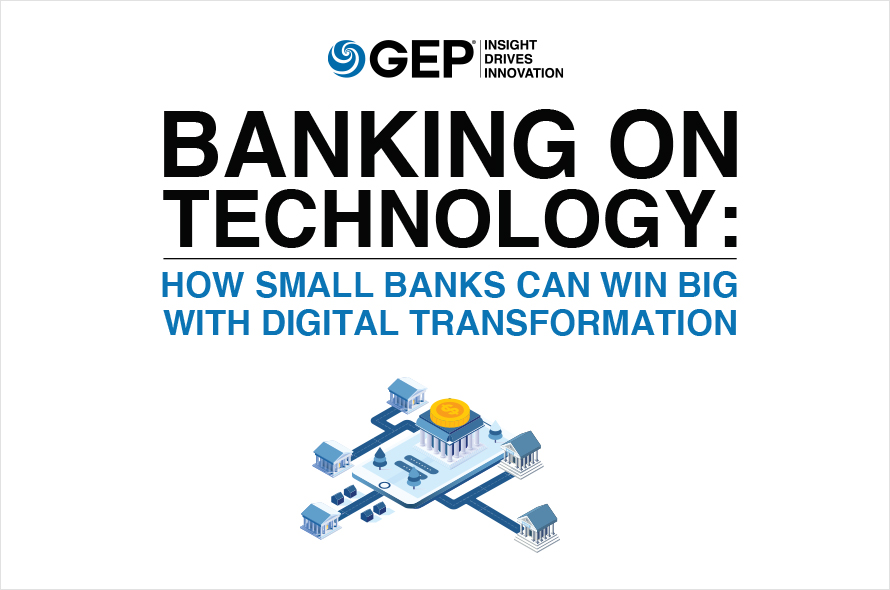Small and midsize banks are built on personal banking relationships, but megabanks benefit from vast customer data. So how can underdogs hold their own?
For many small and midsize banks, the answer lies in strategic spending on customer-centric technologies. But digitalization comes with a hefty price tag, so you can’t make any mistakes.
This guide — Banking on Technology: How Small Banks Can Win Big With Digital Transformation — will help you make an ironclad business case for investing in digitalization. It explains how small banks should take the plunge and outlines the critical needs to prioritize to maximize your ROI and enhance customer satisfaction.
What’s Inside:
- How the right tools can make your customer data a gold mine
- Digitalization investment strategies to improve customer retention
- Tips for grabbing a bigger share of the banking relationship
This paper is a must-read for banking and financial industry professionals looking to maximize their technology investments to compete with big banks.
CEOs and board members of small and midsize banks — typically those with $5 billion or less in annual revenue — have two paths to survival: reduce the cost of serving customers or grow the business. Therefore, they must invest strategically, particularly when it comes to technology.
While small and midsize institutions need to invest to compete with megabanks, they must ensure that spending on process improvement and digitalization will yield returns.
Once small and midsize banks take the digital transformation plunge, the next steps are critical to success. How can bank execs make smart decisions and prioritize investments in digitalization to maximize ROI?
LEVERAGING DATA TO STOP VALUE LEAKAGE
Customer satisfaction should guide technology decisions, but that isn’t always the case. While many banks that serve small and midsize businesses have personal relationships with local business owners, they may lack the data and analytical tools to determine the total relationship value.
For example, for small and midsize retail banks, the largest expense is often the cost of running a branch. When business slows, the knee-jerk reaction is typically to close branches rather than seek new business. However, focusing primarily on cost reduction will increase customer attrition. Institutions need to consider investing in a substantial digital infrastructure to meet current customers’ needs and attract new customers.
THE SOLUTION: DIGITALIZE TO INCREASE THE SCOPE OF SERVICE
Failure to digitalize services risks losing business to more tech-savvy institutions. To meet their customer segment demand, an interim solution would be for the financial institution to partner with an appropriate financial technology (fintech) company.
Fintechs such as Square, PayPal and Amazon cover almost every aspect of banking business processes. If small and midsize banks do not invest in technology, fintechs will crush them.The answer is to develop digital options that meet customer expectations and offer growth potential. For example, customers appreciate a digitalized credit card sales process that can eventually be expanded to the entire credit value chain.
Customers typically maintain some business, such as checking and savings accounts, with their neighborhood bank, but those same customers often go elsewhere for high-value relationships, such as credit card processing, SMB loans and home mortgages.
A majority of U.S. consumers (62%) have accounts or financial products at two or more financial institutions (with about half of consumers using two institutions), according to a Zafin survey of more than 1,200 consumers.1 The results were split into generational segments: Generation Z (Gen Z), millennials and 50 or older. The segments most likely to have multiple relationships were the millennial and 50-plus groups.
Source: Zafin’s 2020 Consumer Banking Survey
Besides offering superior customer service, small and midsize banks can enhance their value by expanding their offerings to include related products and services. For example, a customer securing a home mortgage will likely need assistance with property valuation, moving services, cleaning services and immediate home improvement services.
Keeping customers engaged and satisfied is critical to ensuring that more of their banking business remains with your institution. Advanced analytical tools that support client assessment processes free up small and midsize banks’ credit specialists to nurture high-value relationships.
Banks can also improve customer retention by reducing friction. Routine processes that are not completely digitalized can increase customer dissatisfaction and consume valuable staff resources.
Leaders are also deploying AI-based client analyzers and advanced B2C loan origination models to learn more about clients and predict outcomes. These systems empower underwriters to look at data beyond credit scores, income level and customer asset quality to determine customer attractiveness and minimize risks. Adopting smart credit strategies based on customer-group analytics and forecasts yields step-change improvements. This will ultimately boost the competitiveness of small and midsize segment banking.
Providing a wide range of services at competitive prices requires extensive digitalization. However, once digitalization is in use, the customer is typically less likely to move to another bank for a lower refinancing rate. Instead, the customer will offer you the first chance to match the competitive refinancing rate offered by another lender.
Another way to stay focused on solving customer problems is to eliminate specific pain points. For example, retail banking customers dislike paying fees for international interbank transactions. Some banks and fintech firms do not charge fees for currency exchange on weekdays or charge far below the rates of traditional banks because they leverage their payment infrastructure associated with prepaid debit cards.
Banks with high customer loyalty generally excel at providing digital channels and tools. Customers who used a digital channel for their initial contact and completed digital transactions in their first contact own more banking products. They also have higher credit card spending and tend to buy their next product from their current bank.
THE BUSINESS CASE FOR DIGITAL TRANSFORMATION
Midsize banks can’t afford customer defection. Error-prone human interactions are a major cause of customer dissatisfaction. Technology can prevent most of these issues.
Customer-centric banks excel at offering reliable tools, channels and innovative products. The key is to create products that suit customers, not to expect customers to conform to the products. To outperform their peers, midsize banks must engage customers as advocates. Offering innovative products and leveraging technology to reduce errors will garner recommendations from satisfied clients.
The J.D. Power 2020 U.S. Online Banking Satisfaction StudySM included a number of midsize banks. The ones that excelled were typically leaders in digitalization and supported online and mobile banking.
Expanding the ecosystem of credit card connectivity — and marketing the advantages to younger populations — will ensure that the promoters spend about 25% more and not become detractors.
The use of digital channels for research and purchases is rising across product categories. Banks focused on retaining existing customers must provide a comprehensive set of digital channels, such as investments, credit card spending and points for purchases. This will enable more comprehensive research of their products and promote purchases through strategic partnerships. For example, it is a huge convenience for customers if they can seamlessly go from your accounts to credit cards, to bill payments, investments, home loans and car loans in a single sign-on and use points for merchandise purchases. But many banks don’t support that portability.
Small and midsize banks must look beyond obvious business relationships and mine customer segments to increase reach. For example, they could partner with home protection companies to offer a discount for customers with checking and savings accounts.
PROCUREMENT’S ROLE IN DIGITALIZATION
Procurement should have a seat at the table with the bank’s C-suite and understand revenue-generation strategies, while also fostering alliances and partnerships. Enterprises must approach procurement from an internal business process automation perspective as well as a third-party vendor and risk management view.
Small and midsize banks often don’t have the clout to work with the large managed service providers, so procurement’s role becomes even more critical in sourcing and service relationship management. As a result, procurement needs to determine its most valuable products, prioritize them with the business, execute, demonstrate value, document the process and move to the next project.
References
- “Zafin’s 2020 Consumer Banking Survey,” Zafin, 28 October 2020 | https://zafin.com/resources/zafins-2020-consumer-banking-survey/
- The J.D. Power 2020 U.S.2020 U.S. Online Banking Satisfaction StudySM, 10 June 2020 | https://www.jdpower.com/business/press-releases/2020-us-banking-and-credit-card-mobile-app-satisfaction-studies

